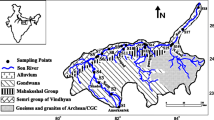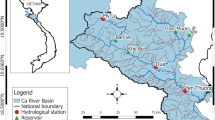Abstract
The riverine dissolved solids, indicating the environment information in watersheds, generally originated from rock weathering, soil erosion and anthropogenic inputs etc. The hydro-chemical characteristics of Danjiangkou Reservoir and its influencing factors after the implementation of South-to-North Water Transfer Project were discussed, based on water quality investigation from October 2017 to July 2018. The water in Danjiangkou Reservoir was moderately alkalescent, with pH ranging from 7.02 to 8.58. The dissolved oxygen, oxidation–reduction potential and conductivity had showed obviously seasonal variations. The total dissolved solids average was 176.14 ± 15.98 mg/L, which was much higher than that average of main rivers in the world. The Ca2+ concentration was the highest among cationic composition, accounting for 50% to 70% of total cations. Among the anion composition, \({\text{HCO}}_{3}^{ - }\) concentrations accounted for more than 70% in most sampling points. Researches showed that carbonates weathering had contributed 70.1% of chemical compositions and mainly controlled the hydro-chemical characteristics. Some riverine ions were affected by silicates weathering. The 17.75% of chemical species were released into rivers by anthropogenic inputs, which proved to be the important factors affecting riverine chemical characteristics, especially in the wet season.









Similar content being viewed by others
References
Milliman JD, Meade RH (1983) World-wide delivery of river sediment to the oceans. J Geol 1–21.
Meybeck M (1982) Carbon, nitrogen, and phosphorus transport by world rivers. Am J Sci 282(4):401–450
Gao Q, Tao Z (2010) Chemical weathering and chemical runoffs in the seashore granite hills in South China. Sci China Earth Sci 08:1195–1204
Chen J, Wang F, Xia X et al (2002) Major element chemistry of the Changjiang (Yangtze River). Chem Geol 187(3):231–255
Kumarasamy P, James RA, Dahms HU et al (2014) Multivariate water quality assessment from the Tamiraparani river basin, Southern India. Environ Earth Sci 71(5):2441–2451
Li S, Gu S, Liu W et al (2008) Water quality in relation to land use and land cover in the upper Han River Basin. China Catena 75(2):216–222
Thomas J, Joseph S, Thrivikramji KP et al (2014) Seasonal variation in major ion chemistry of a tropical mountain river, the southern Western Ghats, Kerala. India Environ Earth Sci 71(5):2333–2351
Fan B, Zhao Z, Tao F et al (2014) Characteristics of carbonate, evaporite and silicate weathering in Huanghe River basin: A comparison among the upstream, midstream and downstream. J Asian Earth Sci 96:17–26
Chetelat B, Liu C, Zhao ZQ et al (2008) Geochemistry of the dissolved load of the Changjiang Basin rivers: anthropogenic impacts and chemical weathering. Geochim Cosmochim Acta 72(17):4254–4277
Varol M, Gökot B, Bekleyen A et al (2013) Geochemistry of the Tigris River basin, Turkey: Spatial and seasonal variations of major ion compositions and their controlling factors. Quaternary Int 304(7):22–32
Hughes HJ, Bouillon S, André L et al (2012) The effects of weathering variability and anthropogenic pressures upon silicon cycling in an intertropical watershed (Tana River, Kenya). Chem Geol 308(2):18–25
Li S, Xu Z, Wang H et al (2009) Geochemistry of the upper Han River basin, China: 3: Anthropogenic inputs and chemical weathering to the dissolved load. Chem Geol 264(1–4):89–95
Zhang Q, Tao Z, Ma Z et al (2016) Riverine hydrochemistry and CO2 consumption in the tropic monsoon region: a case study in a granite-hosted basin, Hainan Island. China Environ Earth Sci 75(5):1–17
Jiang L, Yao Z, Rui W et al (2015) Hydrochemistry of the middle and upper reaches of the Yarlung Tsangpo River system: weathering processes and CO2 consumption. Environ Earth Sci 74(3):2369–2379
Jiang L, Yao Z, Liu Z et al (2015) Hydrochemistry and its controlling factors of rivers in the source region of the Yangtze River on the Tibetan Plateau. J Geochem Explor (0).
Gaillardet J, Dupré B, Louvat P et al (1999) Global silicate weathering and CO2 consumption rates deduced from the chemistry of large rivers. Chem Geol 159(1–4):3–30
Gao Q, Tao Z, Huang X et al (2009) Chemical weathering and CO2 consumption in the Xijiang River basin. South China Geomorphology 106(3–4):324–332
Wu W, Zheng H, Yang J et al (2013) Chemical weathering, atmospheric CO2 consumption, and the controlling factors in a subtropical metamorphic-hosted watershed. Chem Geol 356:141–150
White AF, Blum AE (1995) Effects of climate on chemica weathering in watersheds. Geochim Cosmochim Acta 59(9):1729–1747
Oliva P, Viers J, Dupré B (2003) Chemical weathering in granitic environments. Chem Geol 202(3):225–256
Meybeck M (1987) Global chemical weathering of surficial rocks estimated from river dissolved loads. Am J Sci 287(5):401–428
Stallard RF, Edmond JM (1987) Geochemistry of the Amazon: 3. Weathering chemistry and limits to dissolved inputs. J Geophys Res Oceans (1978–2012) 92(C8):8293–8302.
Liu A J, Wang L. (2000) South-to-North Water Transfer Middle Route Water Source Project-- Danjiangkou Water Control Project. Water Sci Eng Technol s1:63–64.
Su ML, Zhang J, Chen HT et al (2003) Nutrients in the Changjiang and its tributaries. Biogeochemistry 62(1):1–18
Dai GL, Song JM (2014) The source of Danjiang Bishui: a survey of the middle route project of the south-to-north water transfer project. Tianjin People’s Congress 8:37–39
Dai CJ (2018) Exploration and practice of implementing the most stringent water resources management system in Hanjiang River Basin. Yangtze River 49(18):10–14
Li S, Chen Y, Zhang Q (2017) 11-year change in water chemistry of large freshwater Reservoir Danjiangkou, China. J Hydrol 551:508–517
Gibbs M, Bluth G, Fawcett P et al (1999) Global chemical erosion over the last 250 my: Variations due to changes in paleogeography, paleoclimate, and paleogeology. Am J Ofence 299(7–9):611–651
Li S, Xu Z, Hao W et al (2009) Geochemistry of the upper Han River basin, China: 3: Anthropogenic inputs and chemical weathering to the dissolved load. Chem Geol 264(1–4):95
Gao Q, Wang Z (2015) Dissolved inorganic carbon in the Xijiang River: concentration and stable isotopic composition. Environ Earth Sci 73(1):253–266
Dai M, Yin Z, Meng F et al (2012) Spatial distribution of riverine DOC inputs to the ocean: An updated global synthesis. Current Opin Environ Sustain 4(2):170–178
Chen H, Guo SL, Cai XL et al (2005) Analysis of precipitation characteristics and change trends in Danjiangkou of Hanjiang River Basin. Yangtze River 36(11):31–33
Sun YY, Ji HB, Luo JM et al (2006) Hydro-geochemistry and chemical weathering processes of small watersheds in the southern Jiangxi province. Environ Chem 5:550–557
Stallard R F, Edmond J M. (1981) Geochemistry of the Amazon: 1 Precipitation chemistry and the marine contribution to the dissolved load at the time of peak discharge. J Geophys Res Oceans (1978–2012) 86(C10):9844–9858.
Négrel P, Allègre CJ, Dupré B et al (1993) Erosion sources determined by inversion of major and trace element ratios and strontium isotopic ratios in river water: the Congo Basin case. Earth Planet Sci Lett 120(1–2):59–76
Li S, Zhang Q (2008) Geochemistry of the upper Han River basin, China, 1: Spatial distribution of major ion compositions and their controlling factors. Appl Geochem 23(12):3535–3544
Han G, Liu CQ (2004) Water geochemistry controlled by carbonate dissolution: a study of the river waters draining karst-dominated terrain, Guizhou Province. China Chem Geol 204(1–2):1–21
Acknowledgements
This research were financially supported by Fundamental Research Funds for Gentral Public Welfare Research Institutes (Grant No. CKSF2017027/CQ; Grant No. CKSF2019413/CQ; Grant No. CKSF2019185/TB), Opening Project of Ministry of Land and Resources/Key Laboratory of Karst Dynamics in Guangxi (KDL201707), and Natural Science Foundation of Chongqing (cstc2018jcyjAX0479).
Author information
Authors and Affiliations
Corresponding author
Additional information
Publisher's Note
Springer Nature remains neutral with regard to jurisdictional claims in published maps and institutional affiliations.
Rights and permissions
About this article
Cite this article
Zhang, Q., Zhou, H., Lu, Y. et al. The research on riverine hydrochemistry and controlling factors in the Danjiangkou Reservoir. J Radioanal Nucl Chem 324, 507–519 (2020). https://doi.org/10.1007/s10967-020-07096-7
Received:
Published:
Issue Date:
DOI: https://doi.org/10.1007/s10967-020-07096-7




